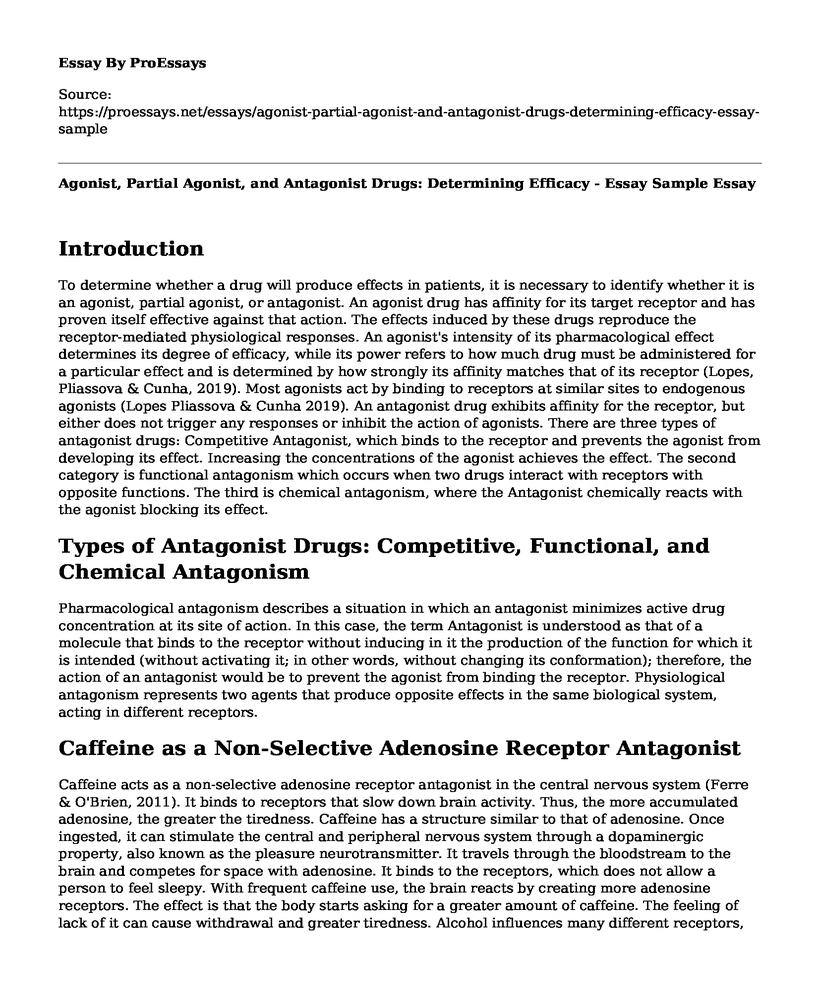Introduction
To determine whether a drug will produce effects in patients, it is necessary to identify whether it is an agonist, partial agonist, or antagonist. An agonist drug has affinity for its target receptor and has proven itself effective against that action. The effects induced by these drugs reproduce the receptor-mediated physiological responses. An agonist's intensity of its pharmacological effect determines its degree of efficacy, while its power refers to how much drug must be administered for a particular effect and is determined by how strongly its affinity matches that of its receptor (Lopes, Pliassova & Cunha, 2019). Most agonists act by binding to receptors at similar sites to endogenous agonists (Lopes Pliassova & Cunha 2019). An antagonist drug exhibits affinity for the receptor, but either does not trigger any responses or inhibit the action of agonists. There are three types of antagonist drugs: Competitive Antagonist, which binds to the receptor and prevents the agonist from developing its effect. Increasing the concentrations of the agonist achieves the effect. The second category is functional antagonism which occurs when two drugs interact with receptors with opposite functions. The third is chemical antagonism, where the Antagonist chemically reacts with the agonist blocking its effect.
Types of Antagonist Drugs: Competitive, Functional, and Chemical Antagonism
Pharmacological antagonism describes a situation in which an antagonist minimizes active drug concentration at its site of action. In this case, the term Antagonist is understood as that of a molecule that binds to the receptor without inducing in it the production of the function for which it is intended (without activating it; in other words, without changing its conformation); therefore, the action of an antagonist would be to prevent the agonist from binding the receptor. Physiological antagonism represents two agents that produce opposite effects in the same biological system, acting in different receptors.
Caffeine as a Non-Selective Adenosine Receptor Antagonist
Caffeine acts as a non-selective adenosine receptor antagonist in the central nervous system (Ferre & O'Brien, 2011). It binds to receptors that slow down brain activity. Thus, the more accumulated adenosine, the greater the tiredness. Caffeine has a structure similar to that of adenosine. Once ingested, it can stimulate the central and peripheral nervous system through a dopaminergic property, also known as the pleasure neurotransmitter. It travels through the bloodstream to the brain and competes for space with adenosine. It binds to the receptors, which does not allow a person to feel sleepy. With frequent caffeine use, the brain reacts by creating more adenosine receptors. The effect is that the body starts asking for a greater amount of caffeine. The feeling of lack of it can cause withdrawal and greater tiredness. Alcohol influences many different receptors, including GABAA receptors, glutamate receptors NMDA and cannabinoid receptors (Shen, 2018). While its exact locations of action remain unknown, researchers believe GABAA channels measure anxiolytic and sedative effects of alcohol as well as motor coordination effects like tolerance dependence and self administration (GABA receptors have an essential part in mediating effects of alcohol).
Drug Addiction and Homeostatic Adaptation to Drugs
Drug addiction results from homeostatic adaptation to drug presence. Dependence can become addictive; defined as maladaptive drug use during stressful circumstances that leads to clinically significant impairment or suffering. Antagonistic power is the most widely used measure because it represents an estimate of the affinity of the Antagonist for the receptor involved. Mechanisms of action of antagonists that act at the level of a given receptor correspond to the strict definition of antagonism; however, the use of drugs that can generate an opposite effect is possible through a mechanism not associated with the receptor that mediates the function to be modified (muscarinic agonists concerning adrenergic function, for example); in this case, the interaction that occurs is known as
Functional or Physiological Antagonism. Consuming both alcohol and caffeine thus causes competitive pharmacological antagonism with the two drugs with opposite effects acting on the same receptor. This means that it is not possible to bind the NMDA receptors, which may participate in abstinence from alcohol.
References
El Yacoubi, M., Ledent, C., Parmentier, M., Costentin, J., & Vaugeois, J. M. (2003). Caffeine reduces hypnotic effects of alcohol through adenosine A2A receptor blockade. Neuropharmacology, 45(7), 977-985.
Ferre, S., & O'Brien, M. C. (2011). Alcohol and caffeine: the perfect storm. Journal of caffeine research, 1(3), 153-162.
Lopes, J. P., Pliassova, A., & Cunha, R. A. (2019). The physiological effects of caffeine on synaptic transmission and plasticity in the mouse hippocampus selectively depend on adenosine A1 and A2A receptors. Biochemical pharmacology, 166, 313-321.
Shen, W. W. (2018). Anticraving therapy for alcohol use disorder: A clinical review. Neuropsychopharmacology reports, 38(3), 105-116.
Cite this page
Agonist, Partial Agonist, and Antagonist Drugs: Determining Efficacy - Essay Sample. (2023, Jun 07). Retrieved from https://proessays.net/essays/agonist-partial-agonist-and-antagonist-drugs-determining-efficacy-essay-sample
If you are the original author of this essay and no longer wish to have it published on the ProEssays website, please click below to request its removal:
- Research on Problems and Solutions of Police Brutality
- The Culture of the Homeless Population Essay
- Essay Example on Women in Colonial America: Role and Experiences
- Combating Islamophobia in Canada: Discrimination, Perspectives and Behaviors - Essay Sample
- Research Paper Sample on Diversity & Talent Issues in Teaching Profession US
- Essay Exampe on Bullying Among Children: Power and Social Status Dynamics
- Essay on The History of Anti-Semitism







